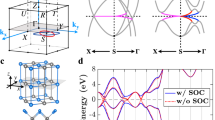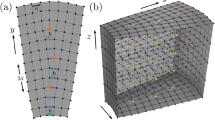Abstract
The crystal symmetry of a material dictates the type of topological band structure it may host, and therefore, symmetry is the guiding principle to find topological materials. Here we introduce an alternative guiding principle, which we call ‘quasi-symmetry’. This is the situation where a Hamiltonian has exact symmetry at a lower order that is broken by higher-order perturbation terms. This enforces finite but parametrically small gaps at some low-symmetry points in momentum space. Untethered from the restraints of symmetry, quasi-symmetries eliminate the need for fine tuning as they enforce that sources of large Berry curvature occur at arbitrary chemical potentials. We demonstrate that quasi-symmetry in the semi-metal CoSi stabilizes gaps below 2 meV over a large near-degenerate plane that can be measured in the quantum oscillation spectrum. The application of in-plane strain breaks the crystal symmetry and gaps the degenerate point, observable by new magnetic breakdown orbits. The quasi-symmetry, however, does not depend on spatial symmetries and hence transmission remains fully coherent. These results demonstrate a class of topological materials with increased resilience to perturbations such as strain-induced crystalline symmetry breaking, which may lead to robust topological applications as well as unexpected topology beyond the usual space group classifications.
This is a preview of subscription content, access via your institution
Access options
Access Nature and 54 other Nature Portfolio journals
Get Nature+, our best-value online-access subscription
$29.99 / 30 days
cancel any time
Subscribe to this journal
Receive 12 print issues and online access
$209.00 per year
only $17.42 per issue
Buy this article
- Purchase on Springer Link
- Instant access to full article PDF
Prices may be subject to local taxes which are calculated during checkout




Similar content being viewed by others
Data availability
Source data are available for this paper. Other data that support the findings of this study are available at Zenodo: https://doi.org/10.5281/zenodo.6336000.
Code availability
MATLAB code used for this study is available at Zenodo: https://doi.org/10.5281/zenodo.6336013.
References
Armitage, N. P., Mele, E. J. & Vishwanath, A. Weyl and Dirac semimetals in three-dimensional solids. Rev. Mod. Phys. 90, 015001 (2018).
Lv, B. Q., Qian, T. & Ding, H. Experimental perspective on three-dimensional topological semimetals. Rev. Mod. Phys. 93, 025002 (2021).
Wan, X. G., Turner, A. M., Vishwanath, A. & Savrasov, S. Y. Topological semimetal and Fermi-arc surface states in the electronic structure of pyrochlore iridates. Phys. Rev. B 83, 205101 (2011).
Wang, Z., Alexandradinata, A., Cava, R. J. & Bernevig, B. A. Hourglass fermions. Nature 532, 189–194 (2016).
Bradlyn, B. et al. Beyond Dirac and Weyl fermions: unconventional quasiparticles in conventional crystals. Science 353, aaf5037 (2016).
Wang, Z. et al. Dirac semimetal and topological phase transitions in A3Bi (A = Na, K, Rb). Phys. Rev. B 85, 195320 (2012).
Wang, Z., Weng, H., Wu, Q., Dai, X. & Fang, Z. Three-dimensional Dirac semimetal and quantum transport in Cd3As2. Phys. Rev. B 88, 125427 (2013).
Bian, G. et al. Drumhead surface states and topological nodal-line fermions in TlTaSe2. Phys. Rev. B 93, 121113 (2016).
Rao, Z. et al. Observation of unconventional chiral fermions with long Fermi arcs in CoSi. Nature 567, 496–499 (2019).
Moll, P. J. W. et al. Transport evidence for Fermi-arc-mediated chirality transfer in the Dirac semimetal Cd3As2. Nature 535, 266–270 (2016).
Zyuzin, A. A. & Burkov, A. A. Topological response in Weyl semimetals and the chiral anomaly. Phys. Rev. B 86, 115133 (2012).
Burkov, A. A. Chiral anomaly and transport in Weyl metals. J. Condens. Matter Phys. 27, 113201 (2015).
Xiong, J. et al. Evidence for the chiral anomaly in the Dirac semimetal Na3Bi. Science 350, 413–416 (2015).
Matsushita, T., Fujimoto, S. & Schnyder, A. P. Topological piezoelectric effect and parity anomaly in nodal line semimetals. Phys. Rev. Research 2, 043311 (2020).
Li, Z. et al. Second harmonic generation in the Weyl semimetal TaAs from a quantum kinetic equation. Phys. Rev. B 97, 085201 (2018).
Takasan, K., Morimoto, T., Orenstein, J. & Moore, J. E. Current-induced second harmonic generation in inversion-symmetric Dirac and Weyl semimetals. Phys. Rev. B 104, L161202 (2021).
Burkov, A. A. Giant planar Hall effect in topological metals. Phys. Rev. B 96, 041110 (2017).
Liu, E. et al. Giant anomalous Hall effect in a ferromagnetic kagome-lattice semimetal. Nat. Phys. 14, 1125–1131 (2018).
Nakatsuji, S., Kiyohara, N. & Higo, T. Large anomalous Hall effect in a non-collinear antiferromagnet at room temperature. Nature 527, 212–215 (2015).
von Neumann, V. J. & Wigner, E. Uber merkwürdige diskrete Eigenwerte. Phys. Z. 30, 291–293 (1929).
Murakami, S., Iso, S., Avishai, Y., Onoda, M. & Nagaosa, N. Tuning phase transition between quantum spin Hall and ordinary insulating phases. Phys. Rev. B 76, 205304 (2007).
Wilde, M. A. et al. Symmetry-enforced topological nodal planes at the Fermi surface of a chiral magnet. Nature 594, 374–379 (2021).
Konschuh, S., Gmitra, M. & Fabian, J. Tight-binding theory of the spin-orbit coupling in graphene. Phys. Rev. B 82, 245412 (2010).
Sichau, J. et al. Resonance microwave measurements of an intrinsic spin-orbit coupling gap in graphene: a possible indication of a topological state. Phys. Rev. Lett. 122, 046403 (2019).
Yuan, Q. Q. et al. Quasiparticle interference evidence of the topological Fermi arc states in chiral fermionic semimetal CoSi. Sci. Adv. 5, eaaw9485 (2019).
Sanchez, D. S. et al. Topological chiral crystals with helicoid-arc quantum states. Nature 567, 500–505 (2019).
Fang, C., Gilbert, M. J., Dai, X. & Bernevig, B. A. Multi-Weyl topological semimetals stabilized by point group symmetry. Phys. Rev. Lett. 108, 266802 (2012).
Moll, P. J. W. Focused ion beam microstructuring of quantum matter. Annu. Rev. Condens. Matter Phys. 9, 147–162 (2018).
Xu, X. et al. Crystal growth and quantum oscillations in the topological chiral semimetal CoSi. Phys. Rev. B 100, 045104 (2019).
Wu, D. S. et al. Single crystal growth and magnetoresistivity of topological semimetal CoSi. Chinese Phys. Lett. 36, 077102 (2019).
Wang, H. et al. de Haas–van Alphen quantum oscillations and electronic structure in the large-Chern-number topological chiral semimetal CoSi. Phys. Rev. B 102, 115129 (2020).
Huber, N. et al. Network of topological nodal planes, multifold degeneracies, and Weyl points in CoSi. Preprint at https://arxiv.org/abs/2107.02820 (2021).
Blount, E. I. Bloch electrons in a magnetic field. Phys. Rev. 126, 1636–1653 (1962).
Helm, T. et al. Correlation between Fermi surface transformations and superconductivity in the electron-doped high-Tc superconductor Nd2−xCexCuO4. Phys. Rev. B 92, 094501 (2015).
Honold, M. M. et al. Magnetic breakdown in the high-field phase of the organic conductor α-(BEDT-TTF)2KHg(SCN)4. Synth. Met. 103, 2093–2094 (1999).
Pezzini, S. et al. Unconventional mass enhancement around the Dirac nodal loop in ZrSiS. Nat. Phys. 14, 178–183 (2017).
Bachmann, M. D. et al. Spatial control of heavy-fermion superconductivity in CeIrIn5. Science 366, 221–226 (2019).
Sun, Y., Zhang, Y., Liu, C. X., Felser, C. & Yan, B. Dirac nodal lines and induced spin Hall effect in metallic rutile oxides. Phys. Rev. B 95, 235104 (2017).
Sun, Y., Zhang, Y., Felser, C. & Yan, B. Strong intrinsic spin Hall effect in the TaAs family of Weyl semimetals. Phys. Rev. Lett. 117, 146403 (2016).
Sodemann, I. & Fu, L. Quantum nonlinear Hall effect induced by Berry curvature dipole in time-reversal invariant materials. Phys. Rev. Lett. 115, 216806 (2015).
Yu, Z. M. et al. Encyclopedia of emergent particles in three-dimensional crystals. Sci. Bull. 67, 375–380 (2022).
Winkler, R. Spin-Orbit Coupling Effects in Two-Dimensional Electron and Hole Systems (Springer, 2021).
Yao, M. et al. Observation of giant spin-split Fermi-arc with maximal Chern number in the chiral topological semimetal PtGa. Nat. Commun. 11, 2033 (2020).
Ma, J. Z. et al. Observation of a singular Weyl point surrounded by charged nodal walls in PtGa. Nat. Commun. 12, 3994 (2021).
Xu, S. et al. Quantum oscillations and electronic structure in the large-Chern-number topological chiral semimetal PtGa. Chinese Phys. Lett. 37, 107504 (2020).
Schröter, N. B. M. et al. Chiral topological semimetal with multifold band crossings and long Fermi arcs. Nat. Phys. 15, 759–765 (2019).
Schröter, N. B. M. et al. Observation and control of maximal Chern numbers in a chiral topological semimetal. Science 369, 179–183 (2020).
Sessi, P. et al. Handedness-dependent quasiparticle interference in the two enantiomers of the topological chiral semimetal PdGa. Nat. Commun. 11, 3507 (2020).
Chang, G. et al. Unconventional chiral fermions and large topological Fermi arcs in RhSi. Phys. Rev. Lett. 119, 206401 (2017).
Rees, D. et al. Helicity-dependent photocurrents in the chiral Weyl semimetal RhSi. Sci. Adv. 6, eaba0509 (2020).
Mühlbauer, S. et al. Skyrmion lattice in a chiral magnet. Science 323, 915–919 (2009).
Bradlyn, B. et al. Topological quantum chemistry. Nature 547, 298–305 (2017).
Zhang, T. et al. Catalogue of topological electronic materials. Nature 566, 475–479 (2019).
Vergniory, M. G. et al. A complete catalogue of high-quality topological materials. Nature 566, 480–485 (2019).
Tang, F., Po, H. C., Vishwanath, A. & Wan, X. G. Comprehensive search for topological materials using symmetry indicators. Nature 566, 486–489 (2019).
Acknowledgements
We would like to acknowledge J. Harms for the assistance on graphic design. This work was funded by the European Research Council (ERC) under the European Union’s Horizon 2020 research and innovation programme (MiTopMat; grant agreement no. 715730). This project received funding by the Swiss National Science Foundation (grant no. PP00P2_176789). C.L. and L.H. are supported by the Office of Naval Research (grant no. N00014-18-1-2793) and Kaufman New Initiative research grant no. KA2018-98553 of the Pittsburgh Foundation. K.M. and C.F. acknowledge financial support from the ERC advanced grant no. 742068 ‘TOP-MAT’, European Union’s Horizon 2020 research and innovation programme (grant nos. 824123 and 766566) and Deutsche Forschungsgemeinschaft (DFG) through SFB 1143. Additionally, K.M. acknowledges Max Plank Society for funding support under Max Plank-India partner group project. B.A.B. acknowledges funding from the ERC under the European Union’s Horizon 2020 research and innovation programme (grant agreement no. 101020833). B.A.B. is also supported by the US Department of Energy (grant no. DE-SC0016239) and partially supported by the National Science Foundation (EAGER grant no. DMR 1643312), a Simons Investigator grant (no. 404513), the Office of Naval Research (ONR grant no. N00014-20-1-2303), the Packard Foundation, the Schmidt Fund for Innovative Research, the BSF Israel US foundation (grant no. 2018226), the Gordon and Betty Moore Foundation through grant no. GBMF8685 towards the Princeton theory program and a Guggenheim Fellowship from the John Simon Guggenheim Memorial Foundation. B.A.B. and C.L. are supported by the NSF-MERSEC (grant no. MERSEC DMR 2011750). B.A.B. gratefully acknowledges financial support from the Schmidt DataX Fund at Princeton University made possible through a major gift from the Schmidt Futures Foundation. B.A.B. received additional support from the Max Planck Society. Further support was provided by the NSF-MRSEC (no. DMR-1420541), BSF Israel US foundation (no. 2018226) and the Princeton Global Network Funds.
Author information
Authors and Affiliations
Contributions
The crystals were synthesized and characterized by K.M., C.S. and C.F. The experimental design, FIB microstructuring and magnetotransport measurements were performed by C.G., C.P., J.D., X.H. and P.J.W.M. L.H., C.L. and B.A.B. developed and applied the general theoretical framework, and the analysis of experimental results was done by C.G., C.P. and P.J.W.M. The band structures were calculated by Y.S., F.-R.F. and C.F. All the authors were involved in writing the paper.
Corresponding authors
Ethics declarations
Competing interests
The authors declare no competing interests.
Peer review
Peer review information
Nature Physics thanks Christian Pfleiderer and the other, anonymous, reviewer(s) for their contribution to the peer review of this work.
Additional information
Publisher’s note Springer Nature remains neutral with regard to jurisdictional claims in published maps and institutional affiliations.
Supplementary information
Supplementary Information
Supplementary Figs. 1–28 and Supplementary Sections I–VII.
Source data
Source Data Fig. 2
Source data for Fig. 2b.
Source Data Fig. 3
Source data for Fig. 3.
Source Data Fig. 4
Source data for Fig. 4c,d.
Rights and permissions
About this article
Cite this article
Guo, C., Hu, L., Putzke, C. et al. Quasi-symmetry-protected topology in a semi-metal. Nat. Phys. 18, 813–818 (2022). https://doi.org/10.1038/s41567-022-01604-0
Received:
Accepted:
Published:
Issue Date:
DOI: https://doi.org/10.1038/s41567-022-01604-0
This article is cited by
-
Quantum oscillations of the quasiparticle lifetime in a metal
Nature (2023)
-
Large curvature near a small gap
Nature Physics (2022)



